Optimising carbon fixation 1 LECTURE 3
1/59
There's no tags or description
Looks like no tags are added yet.
Name | Mastery | Learn | Test | Matching | Spaced |
|---|
No study sessions yet.
60 Terms
Once CO2 has been delivered to the chloroplast stroma
reacts with the primary caboxylase→ Rubisco
When did Rubisco evolve
3.6-3.8 billion years ago
before the atmosphere became oxygenated
2.4 bya

Rubisco features
most abundant protein on Earth
accounts for up to 50% of the total soluble protein in a leaf
corresponds to 10kg of protein per person
L8S8 version→ 550kiloDaltons
one of the largest most complex enzymes known
Variety of Rubisco strucutres
some variation in structure and function
But what version do plants and cyanobacteria use
L8S8 version:
4 pairs of large subunits
4 small subunits
on top and below to hold it together
each pair of subunits sits top to tail
enclose two active sites
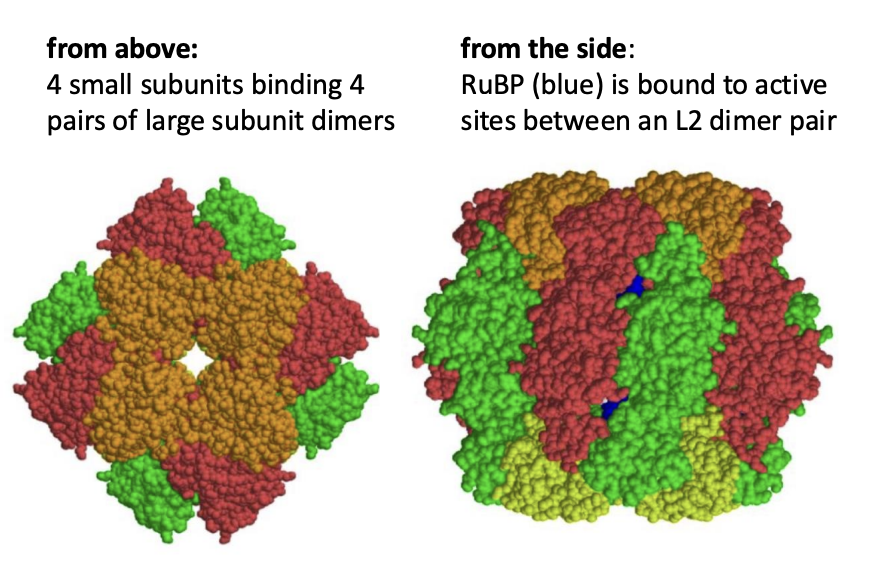
Biosynthesis of Rubisco invovles:
Multiple steps of
transcription
translation
assembly of subunits
Function of Rubisco: even though pressure to select CO2 over O2 for the past 2 billion years
Rubisco still only poorly distinguishes one from the other!
compete for the activated sites on Rubisco
→ carboxylase : oxygenase events
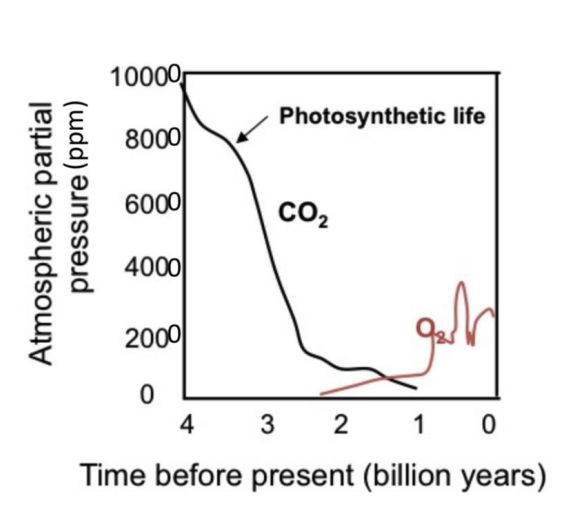
@ 20 degrees and atmospheric oxygen levels (21%)
carboxylase: oxygenase
4:1
Value of Km for Co2
9 microMol but [CO2] is 0.04% in present day
→ means that Rubisco can only ever work at half maximum velocity
How Carboxylase part of Rubisco works
combines CO2 with a 5 carbon compound
RuBP→ Ribulose 1,5-biphosphate
Creates 3-PGA
phosphoglyceric acid
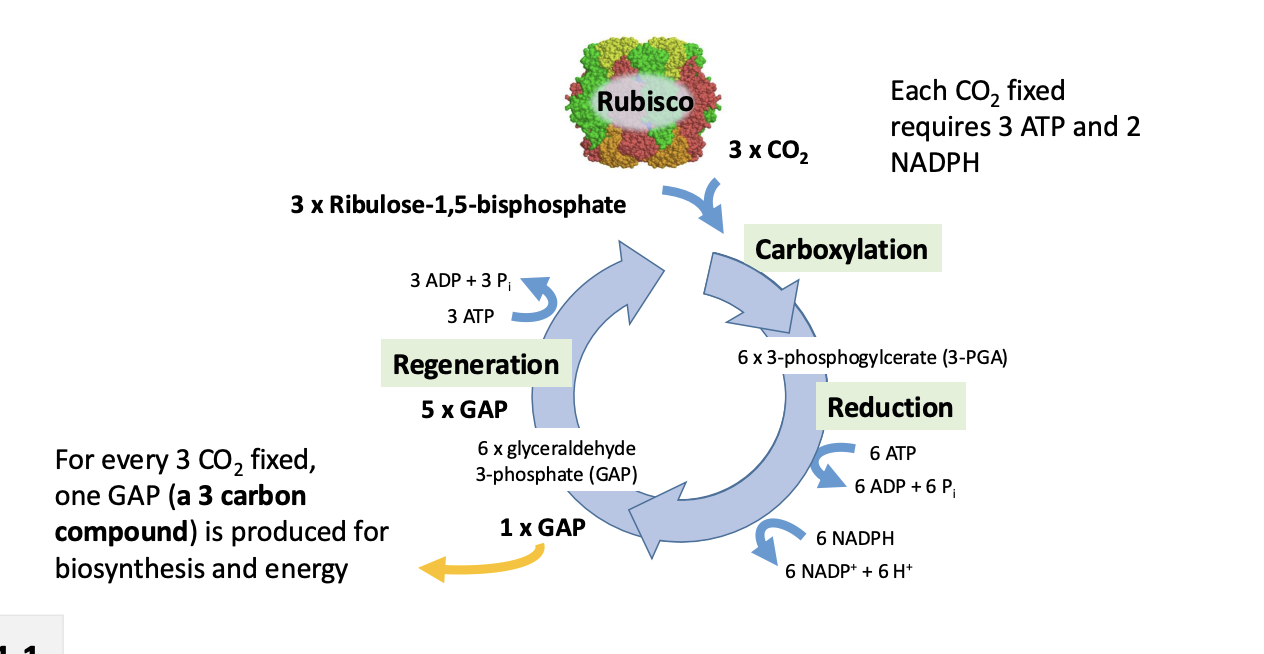
How Oxygenase Rubisco works
No carbon assimilation
Fixes O2 to RuBP
Makes 2-phosphoglycolate (PG)
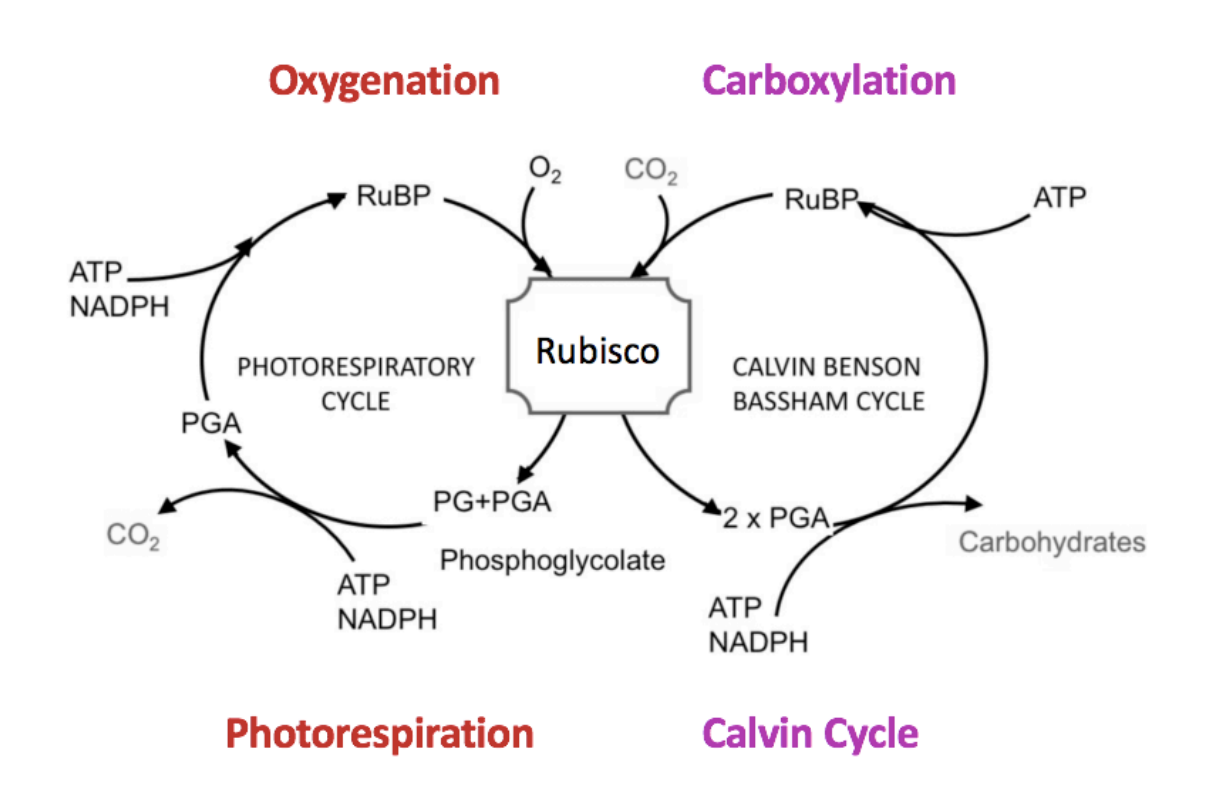
But phosphoglycolate is inhibits some enzymes in the Calvin cycle
Must be removed and made into molecules that are compatible with plant metabolism→ Photorespiration
Photorespiration: What organelles are involved
peroxisomes
mitochondria
many others
This is so the PG can be removed so it doesn’t effect the calvin cycle enzymes
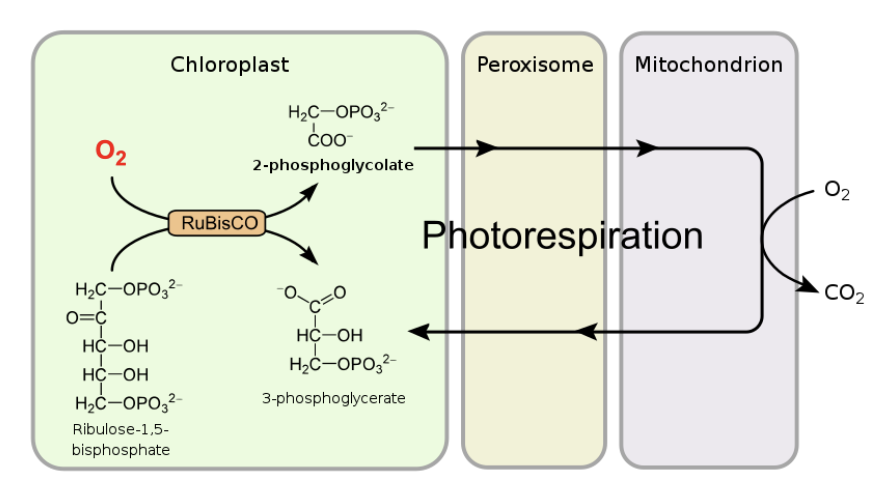
Photorespiration: What happens?
PG is converted into PGA
releases CO2
Uses ATP and NADPH
Converted back to RuBP
Uses ATP and NADPH
overall: recycles the toxic waste→ releases CO2 in the light
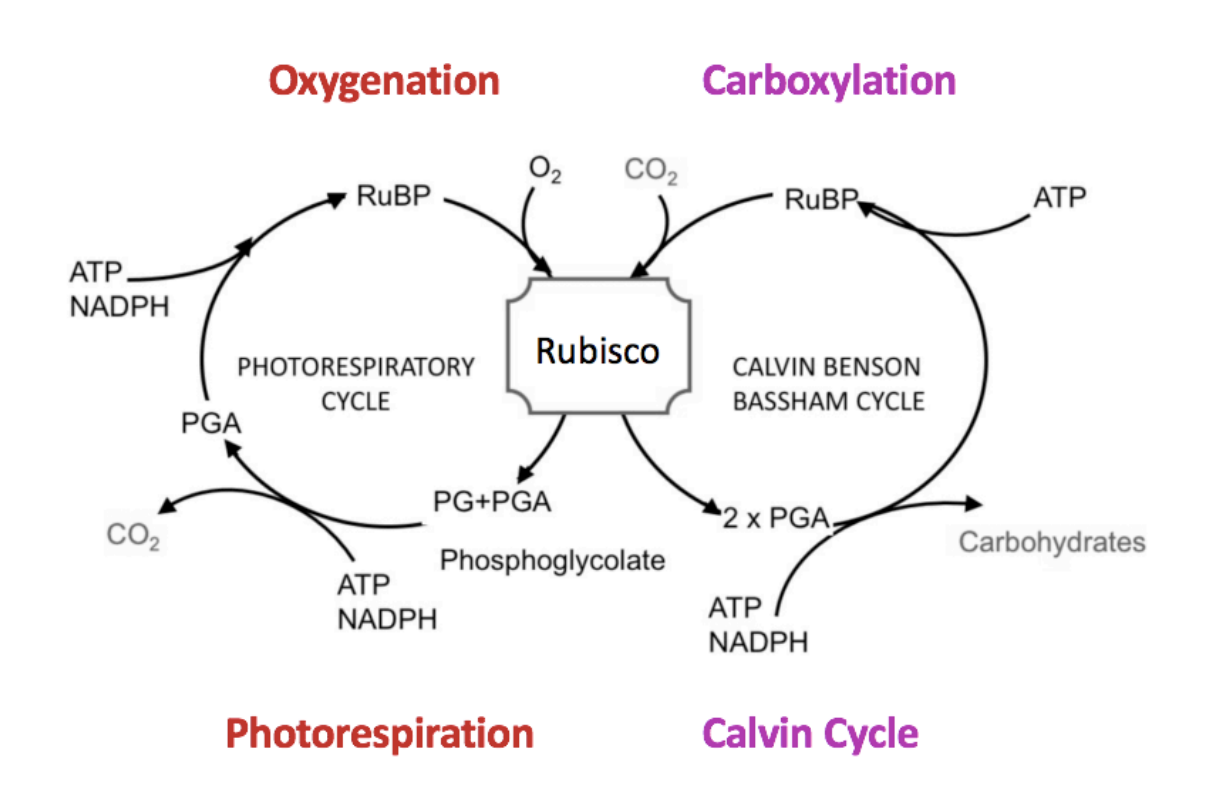
Why is this allowed to happen?
Cannot distinguish between CO2 and O2 very well
Maybe it is advantageous?→ linked to
Sources of Serine
Role in nitrogen assimilation
Too difficult to change a highly conserved and massive protein
one mutation/change could result in failure
→ no longer viable
important role in photosynthesis
very costly if wrong change was made
Why is photorespiration bad for plant!
Energetically expensive
Product inhibits Calvin cycle enzymes
Stop CO2 taken up
Also releases CO2
Overall really decreases overall CO2 fixation and Calvin cycle
photosynthesis is down→ cannot grow as much etc…
Blackman’s limiting factor analysis can be used to compare the sensitivity and operating efficiency of Rubisco
Plotting Carbon assimilation rates as a function of CO2 concentration

In order to remove the effects of stomatal limitation
Plot
y→photosynthetic CO2 assimilation rate
A, micro.mol CO2 m-2s-1
against
x→ mesophyll gas phase CO2 concentration
Ci, ppm or micromol mol-1
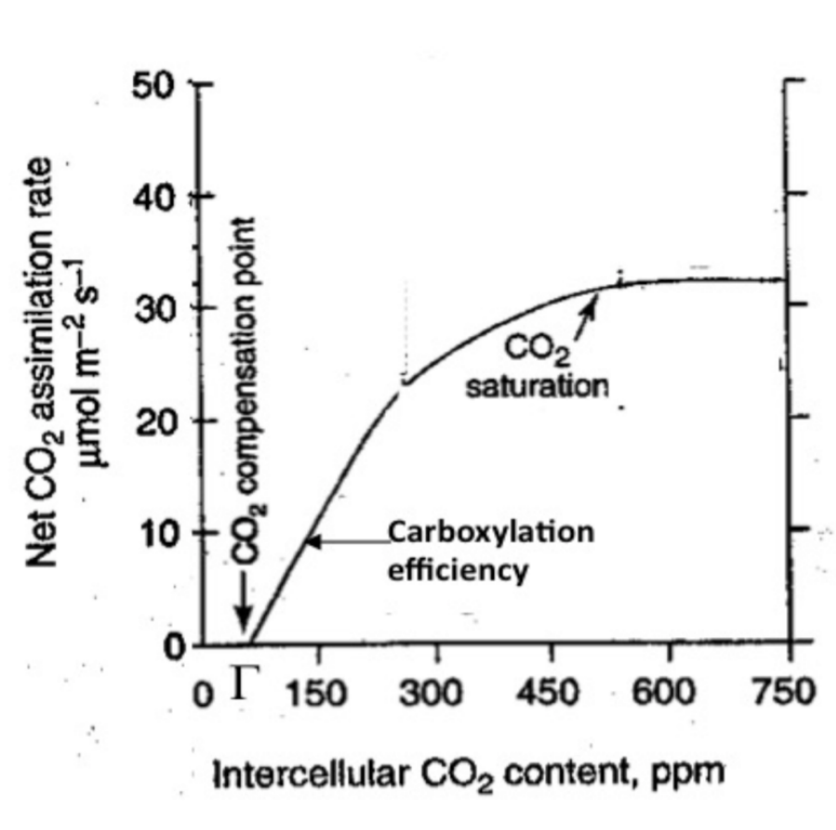
Analysis of this plot
Initial slope
revealed the carboxylation efficiency of Rubisco
X-axis Intercept
give CO2 compensation point
where A=0 and Co2 uptake is balanced by (photo)-respiration release)
→is a measure of oxygenase activity!

Because Rubisco catalysis is sensitive to O2
When decrease O2, there is a reduction in oxygenase activity!
→ leads to more CO2 assimilation
At low O2 concentration→ graph @ 1.9% vs 20%
Reduced oxygenase activity
Carboxylase Efficiency (Rubisco activity) Increased
CO2 Compensation point reduced: from 40-10
Meaning that less CO2 concentration is needed to get CO2 assmilation to meet CO2 loss
→ Less CO2 lost because photorespiration is lower!
Max assmilation is higher
A Decrease Assilimation at high CO2 (at the end of the graph)
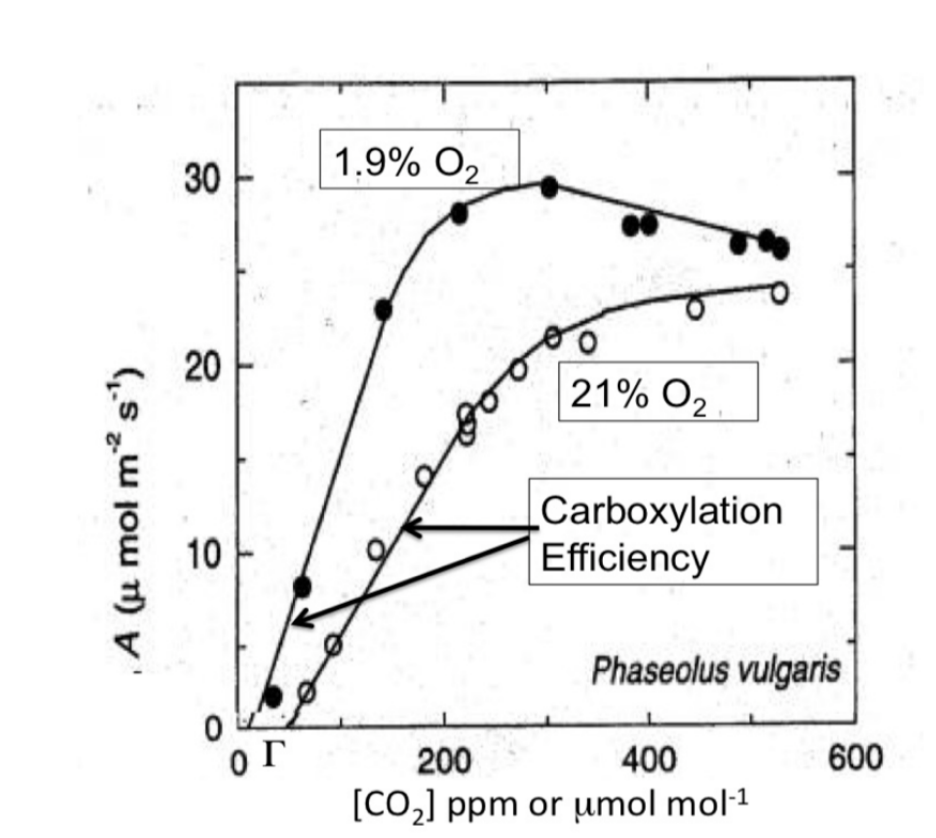
Why is there decreased assimilation at high CO2?
Due to PO43- limitations in the stroma
i.e something else becomes the limiting factor!
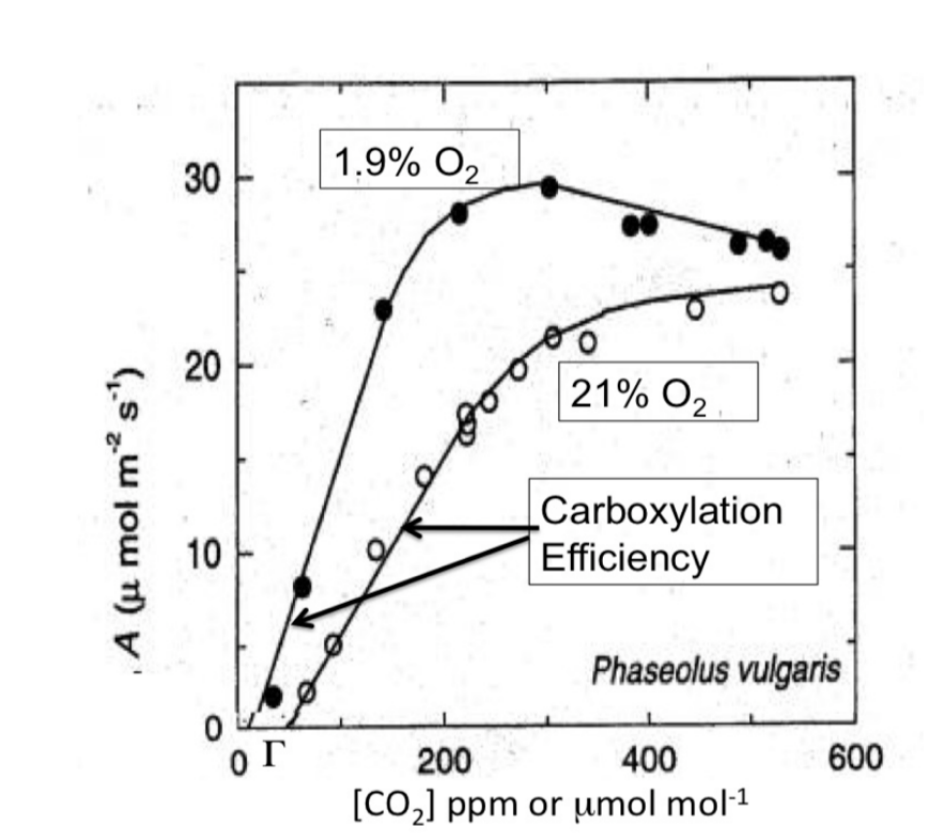
Therefore to limit oxygenase activity and photorespiration:
Need to lower O2
Increase CO2 vs O2
→ concentrate CO2
→ This is the strategy used by C4 and CAM plants to icrease the efficiency of Rubisco
So does increasesing CO2 in the atmosphere help photosynthesis then?
Last 200 years, 280 ppm → 400ppm
BUT→ also comes with
increased temp
drought
atmospheric pollution
OVERALL: outweighs the benefits for the productivity of natural vegetation and crops
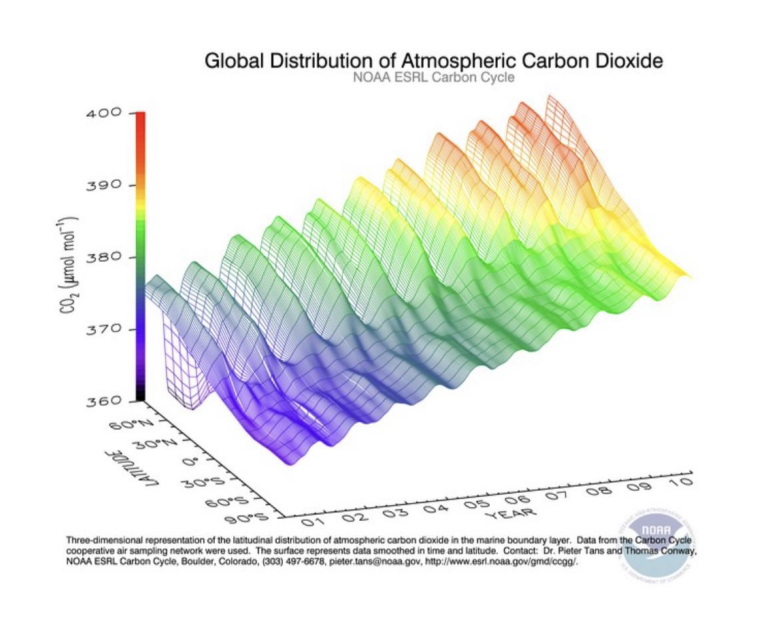
Balancing the benefits and negatives
Depends on the
species
region

Issue with increased temperatures and drought
Warmer and water is limiting:
Photorespiration is more costly
Due to this
There has been convergent evolution to tackle this:
All using carbon concentrating mechanisms to increase the efficiency of carboxylation and water use
Cyanobacteria
Concentrate CO@ in carboxysomes
Algae
Concentrate CO2 in pyrenoids within their chloroplasts
Plants
C4 and CAM plants
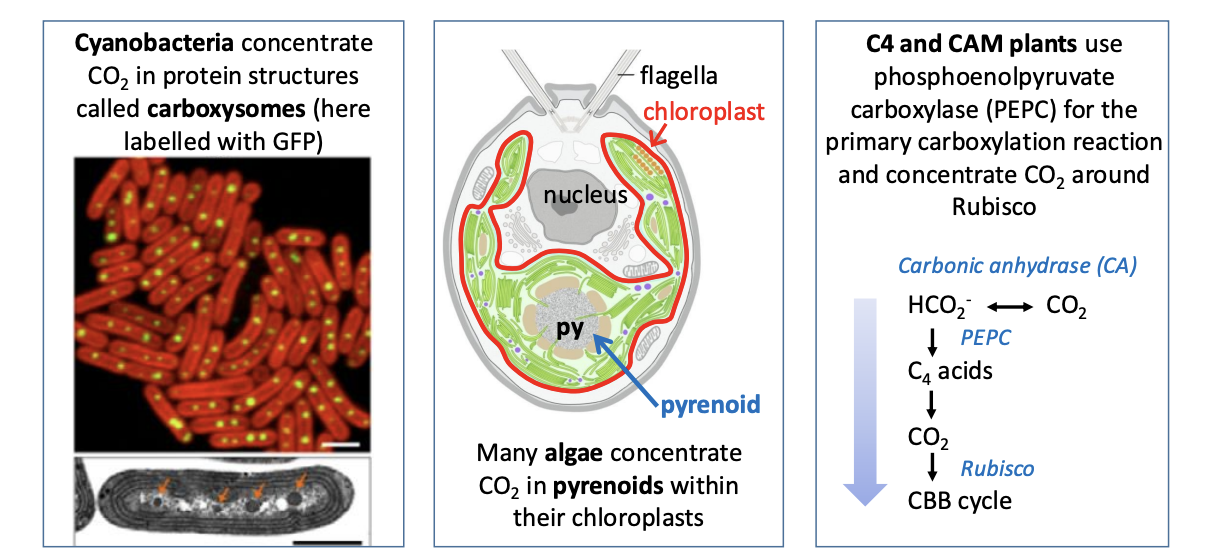
The C3 pathway→ usual photosynthesis
Rubisco fix CO2 to Ribuloe Biphosphate
Makes 9-carbon intermediate
Cleaved into two 3 carbon molecules (phospholyceric acid) PGA
This is the 3 carbon major product (C3)
Reduced to glyceraldehyde 3-phosphate (G3P)
useing ATP and NADPH
Regenerated into RuBP with ATP

C3 plants
Tomatoes
Barley
Wheat
Potatoes
Soybean
Many staple diets worldwide
Where are C3 plants found
temperate biomes
tropical forest biomes
C4 Plant pathway (general)
CO2 converts into carbonic acid
with carboninc anhydrase
This is fixed to phosphoenolpyruvate (PEP) into Oxaloaxetate (OAA) using PEP carboxylase (PEPC)
OAA rapidly converted int malate or aspartate
This is the C4 primary product
This C4 is then moved, decarboxylated and the CO2 off of this is used by Rubisco for the normal Calvin cycle process
How C4 mechanism concentrates CO2
Spatial Separation
C4 intermediates made in the mesophyll
Transported to bundle sheath cells
Decaboxylated here
So the Rubisco in the bundle sheath cells are surrounded by a higher concentration of CO2
→ Leads to concentrations of 1-2%
Overall: means that the rubsico has less O2, so less oxygenase reaction, less photorespiration and more photosynthesis!
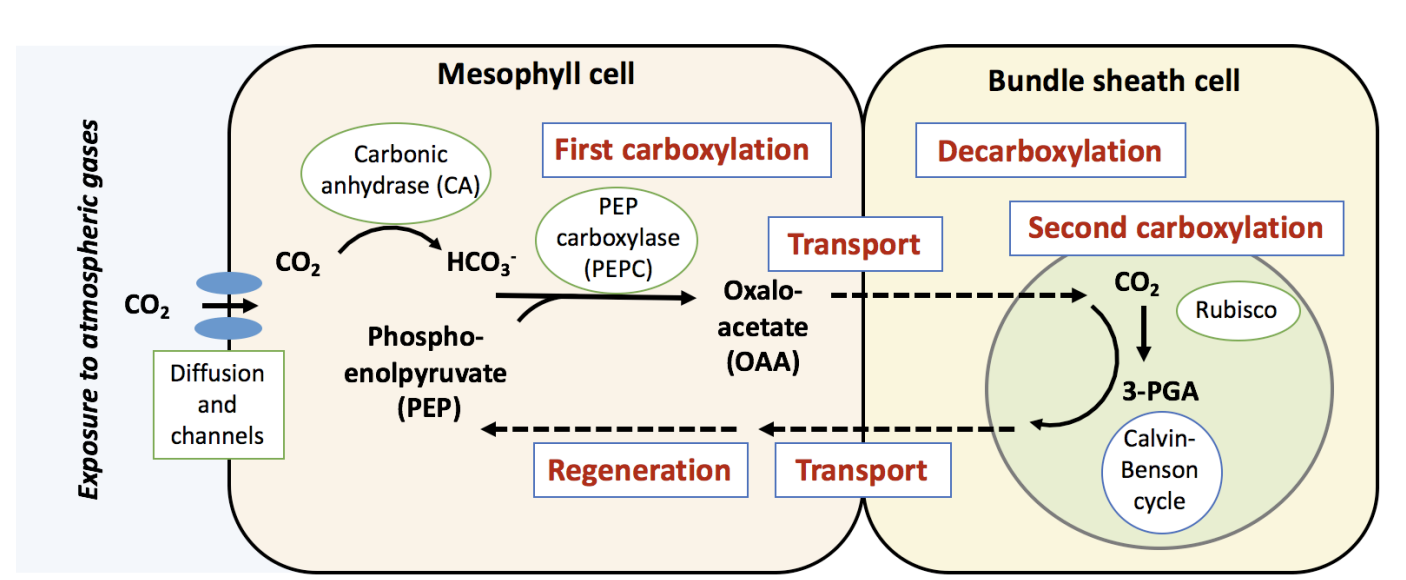
Types of C4 plants
Found in 18 families
Grasses:
Corn (Maize, Zea mays)
Sugar cane
Sorgum
Pearl Millet
Foxtail millet
Tef
3% of angiosperms are C4
→ 25% of terrestrial productivity!
C4 pathway (in depth)
Fixation
Transport
Decarboxylation
Transport and Regeneration
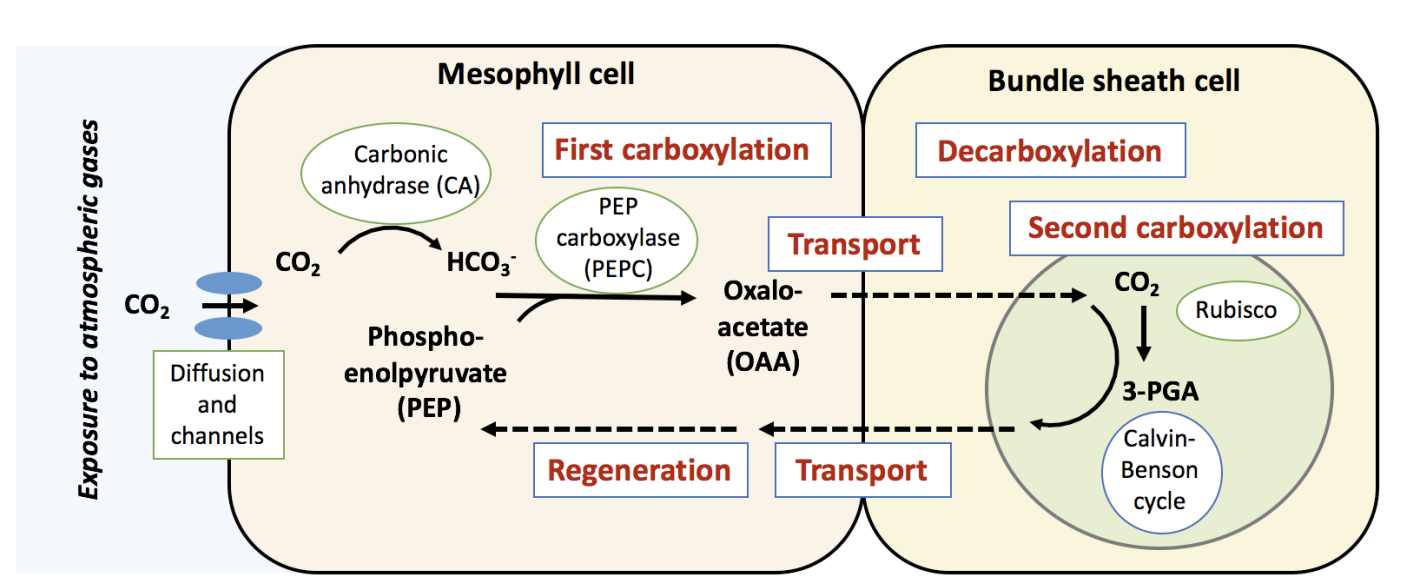
Fixation
Mesophyll cells
Carbonic anhydrase CO2→ HCO3-
PEPC (found in cytoplasm) activated in the light via phosphorylation of specific kinase
Makes C4 malate and aspartate
PEP +HCO3 → OAA
OAA→ malate and aspartate
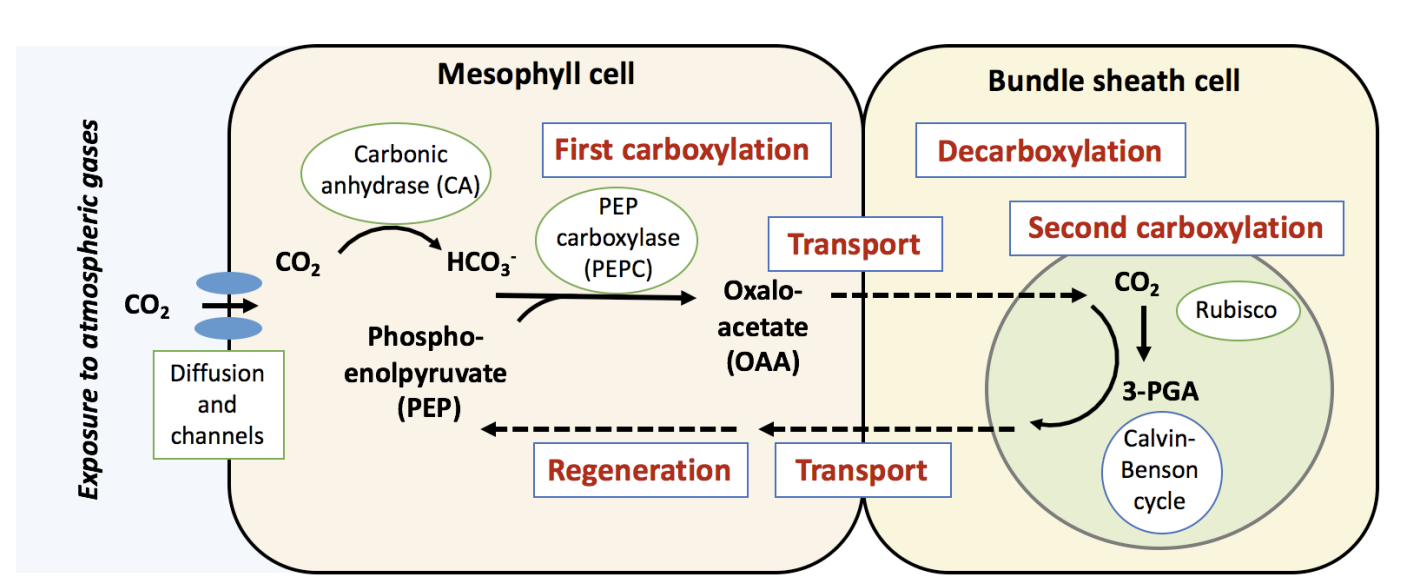
Why is PEPC used?
Much higher affinity (low Km) for inorganic carbon
Compared to Rubisco
→ maintains a steep diffusion gradient for CO2 into the leaf!
Lots of CO2 can get in→ great for concentrating the CO2 inside
Transport
Malate and aspartate moved to bundle sheath
Via symplastic connections→ plasmodesmata
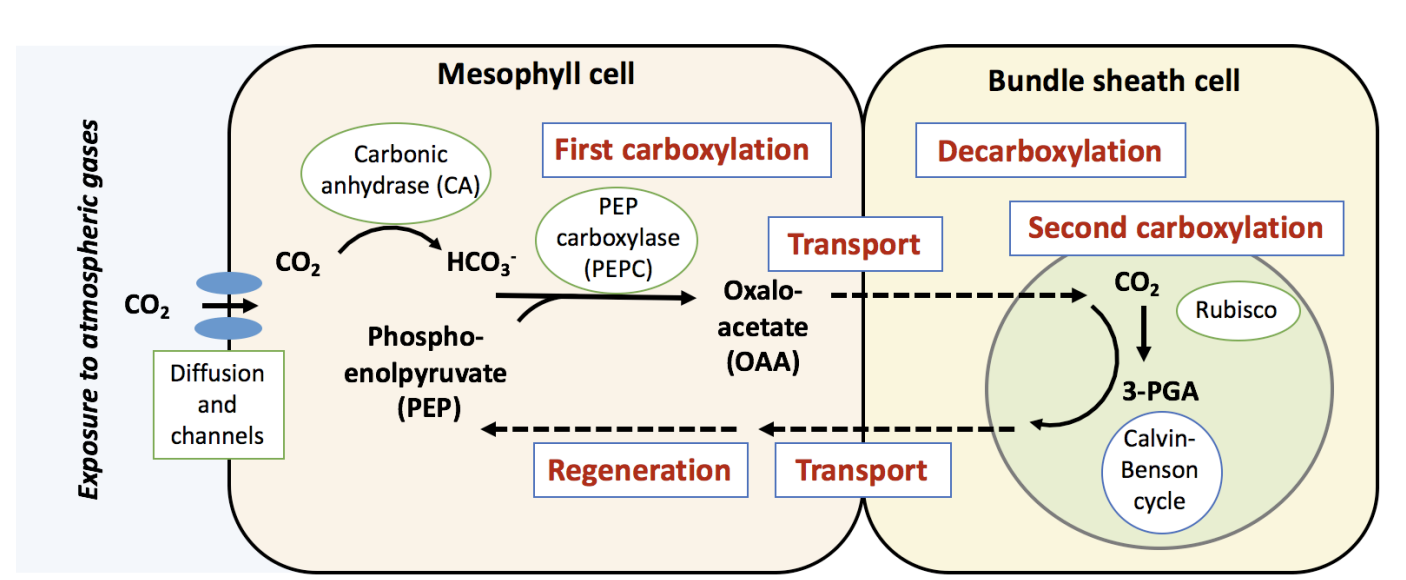
Decarboxylation
Regenerates CO2 from C4 organic acids
Forms 1-2% CO2 concentration in the bundle sheath
Rubisco is therefore much more efficient now
photorespiration completely suppressed
initiates the Calvin cycle
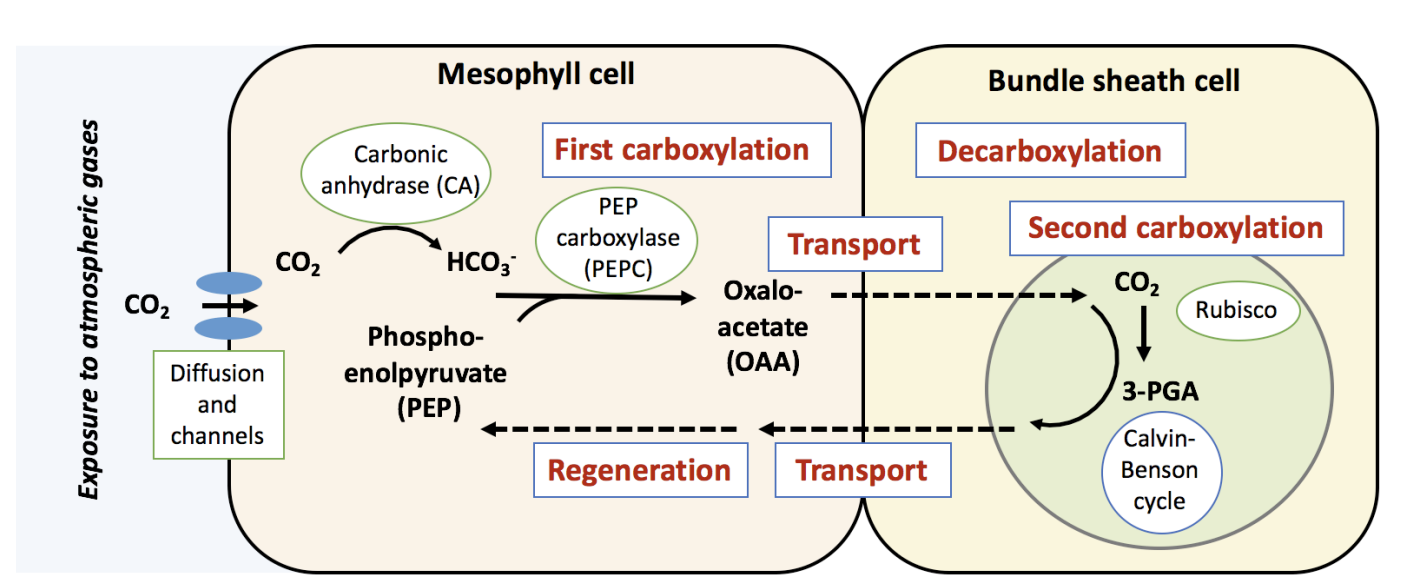
Transport and regeneration
C3 residue diffused back to mesophyll cells
Why?
Needs to be regenerated back into PEP so the mesophyll cells have something PEPC can convert again
Uses:
pyruvate phosphate dikinase (PPDK)
ATP
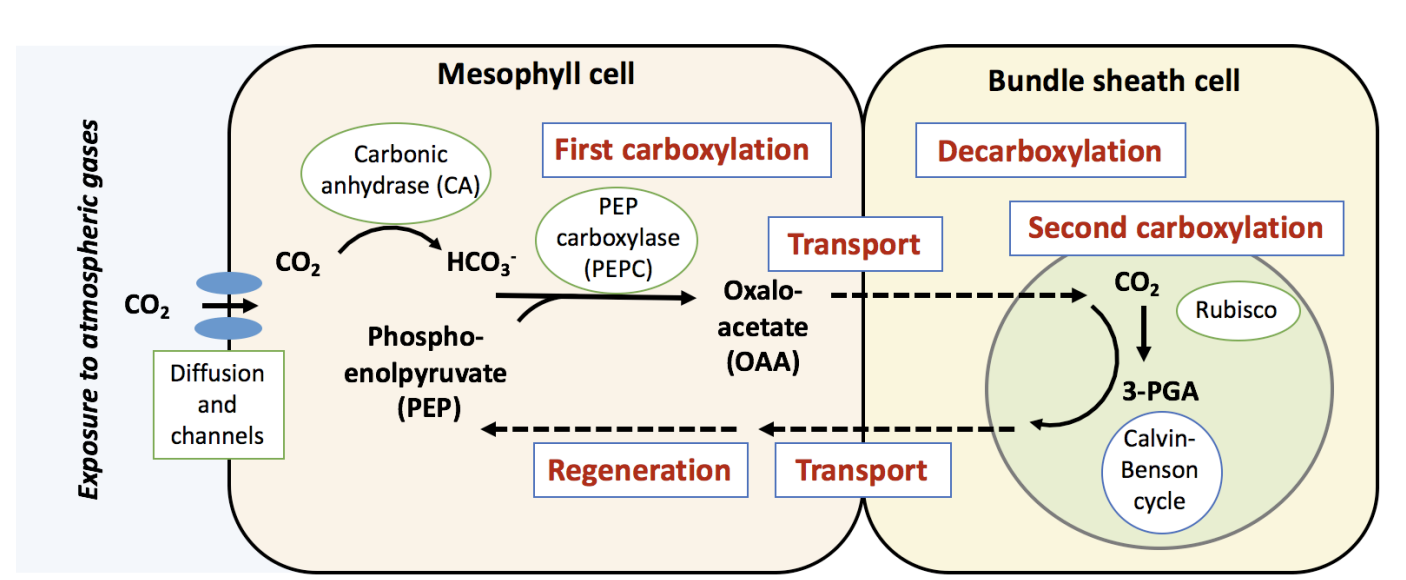
To achieve this spatial separation
Have kranz “wreath” anatomy
Kranz Wreath anatomy
Bundle sheath surrounding vascular tissue
Thick walled
suberized→ impregnate with suberin in cell wall
→ Increase space for photosynthesis
Many plasmodesmata
connecting mesophyll → bundle sheath
Higher Vein density to C3 plants
→ coz more products made??
More chloroplasts in bundle sheath
Than C3 plants
→ coz more photosynthesis happening?
→ less in mesophyll so more PEPC than rubisco so can concentrate CO2 more?
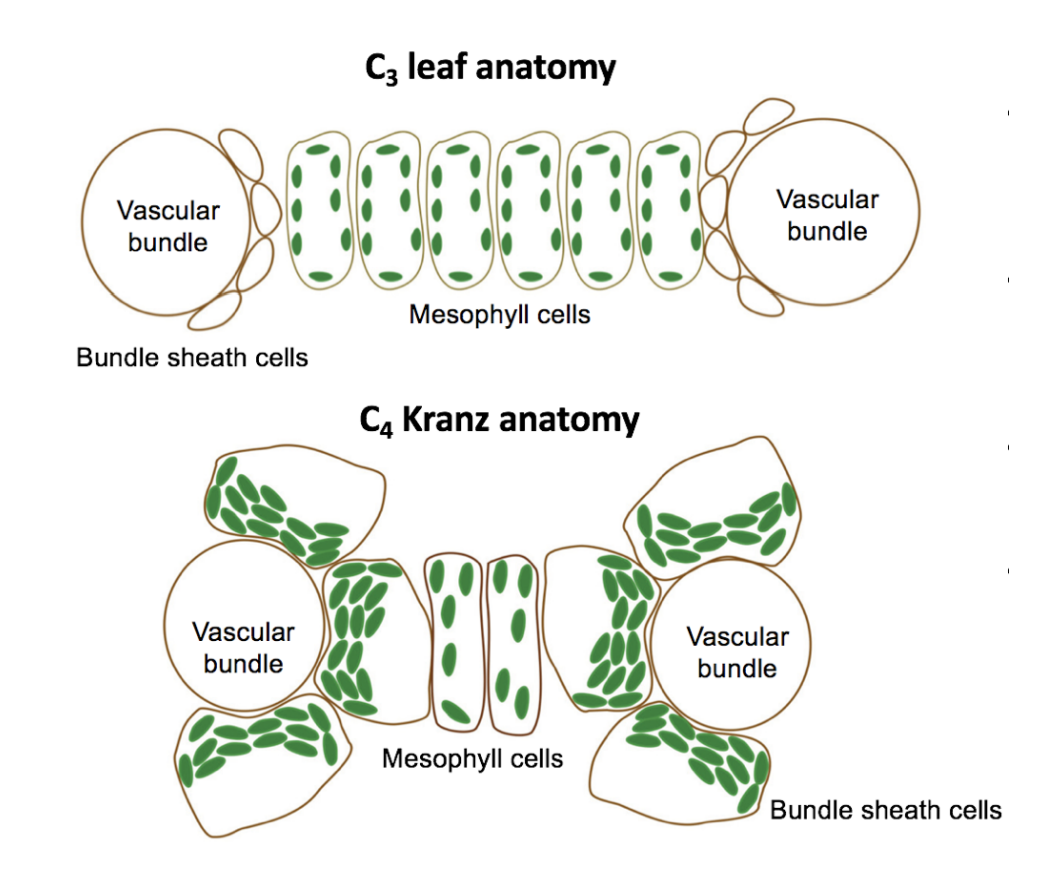
What this enables
Efficient transport of metabolise between cells
Efficient carbon fixation by Rubisco in the bundle sheath

Why called a wreath?
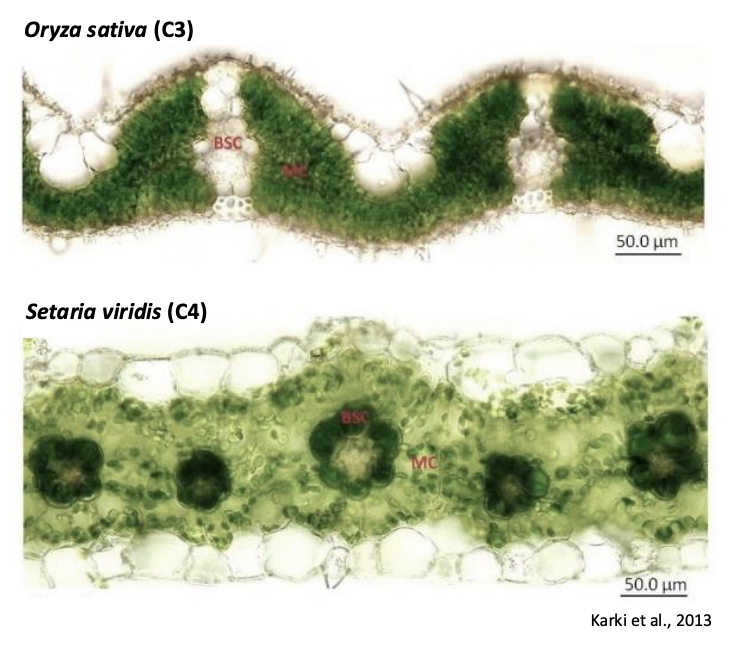
Advantages of suppressing photorespiration
Energetics→ cheaper at higher temp
CO2 compensation point→ lower
Efficiency of light use (quantum yield)→higher
Water Use→ higher efficiency

Energetics→ How costly is C4?
Regeneration in C4 costs 2 ATP per CO2 used
THEREFORE: more expensive than C3 pathway (if photorespiration did not occur)
Enegetics→ C3 vs C4 at 20 degrees
similar energetic ATP costs
Energetics→ As temp increases from C3 to C4
Carboxylase rate doubles
But
Oxygenase rate trebles
In C3 plants
Energetics→ when is C4 more energetically beneficial?
Photorespiration increases with temperature
But C4 costs do not increase with temperature
So at higher temperatures, C4 becomes less costly than C3, per CO2 assimilated
CO2 compensation point
C3→ 50-70ppm
and increases with temperature
C4→ 0-10 ppm
lower compensation point
Coz less CO2 is being lost
Do not need to compensate at much!
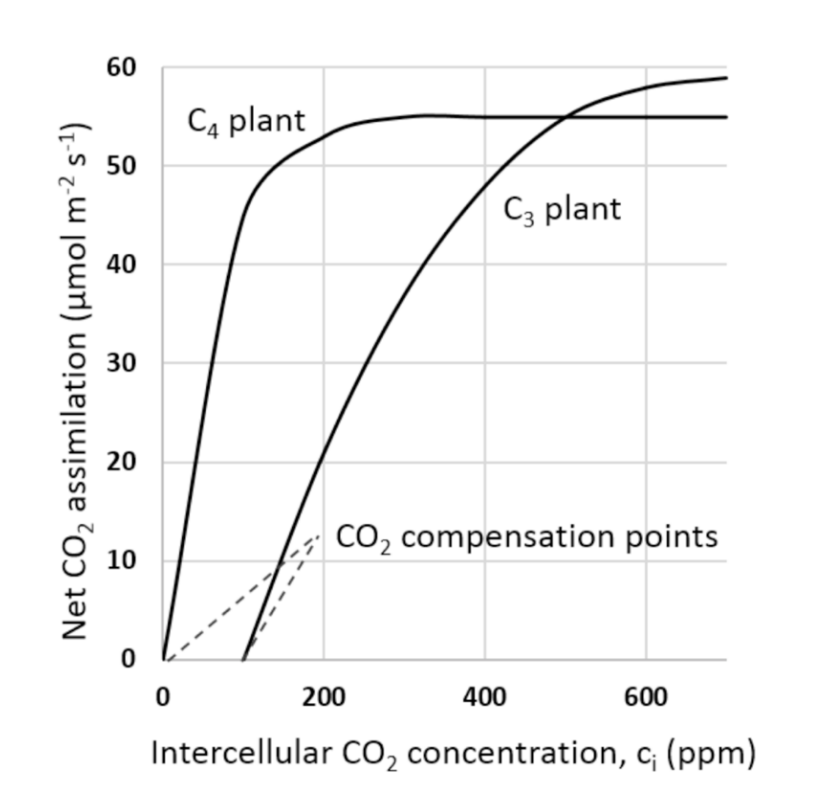
Efficiency of light use→ Initial slope of graph
Quantum yield:
Higher for C4 plants
→ fix more CO2 per photon absorbed
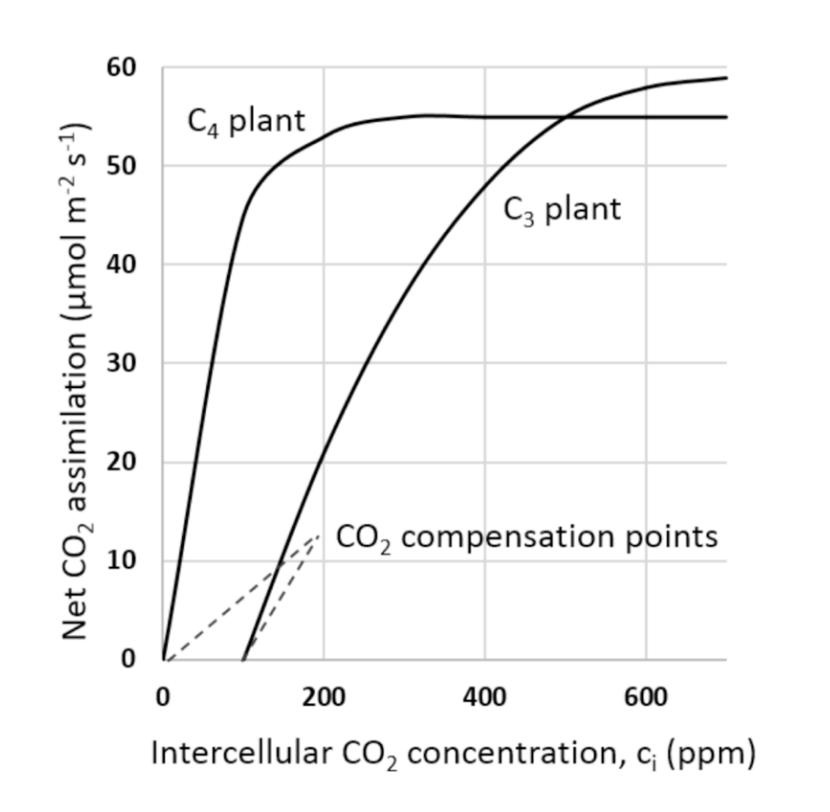
Water use
PEPC higher affinity for CO2
Stomata do not need to be as wide to get enough CO2 in
So Stomata have lower conductance
not easy for gases to move in and out
Because stomata closed
For the same CO2 assimilation rate
Means:
Higher water use (assimilation/evaporation)
Less water lost!
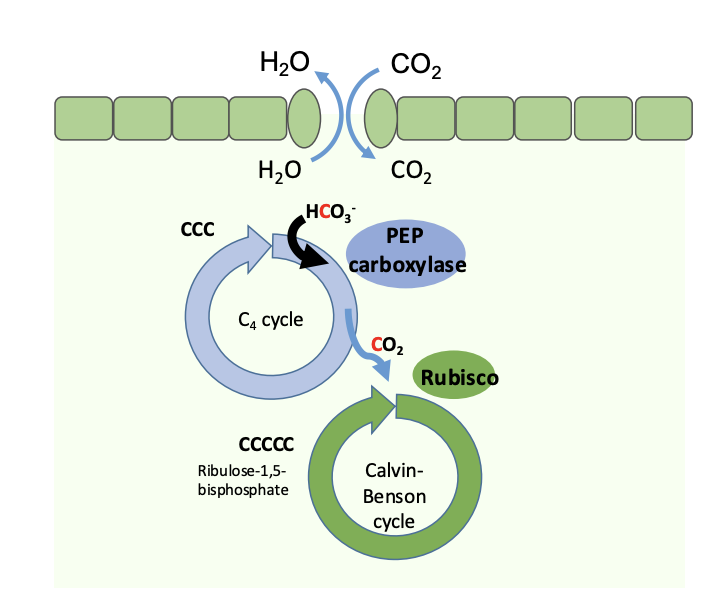
Water use→ ecological advantage
E.g Grasses:
Found in fire-dominated Savannah regions
tropics
Tall grass in
high latitude
North America
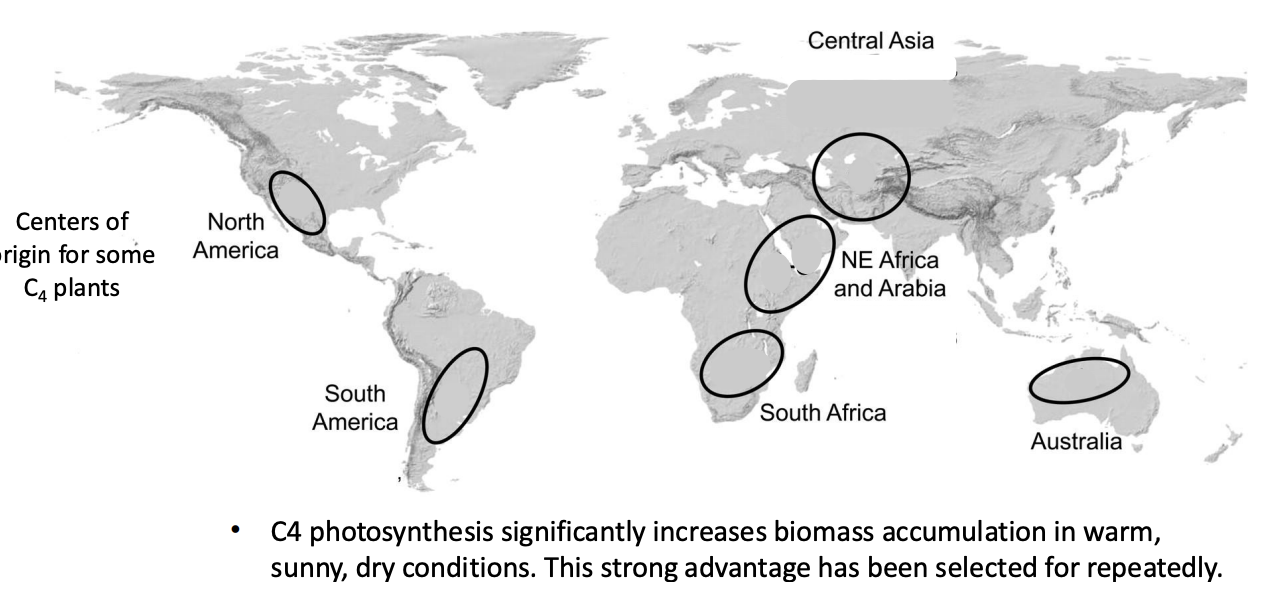
Where C4 normally found
hot summers
tropical regions
C4 plants in the UK?
Probably not the best climate for it:
typically found in association with hot summers or tropical regions
→ Only 4 species are native
Salsola kali
Spartina X
Cyperus longus
Atriplex lacinata
Growing C4 crops in the UK?
Maize:
often sickly
chlorotic
→ Not great
Miscanthus
Offers the prospect of biofuels for the future
When C4 pathway evolved?
20 mya
When CO2 levels fell to around 280ppm
When huge climate change due to uplift of the himalayan plateau
How many times has it evolved?
60 times independently in angiosperms
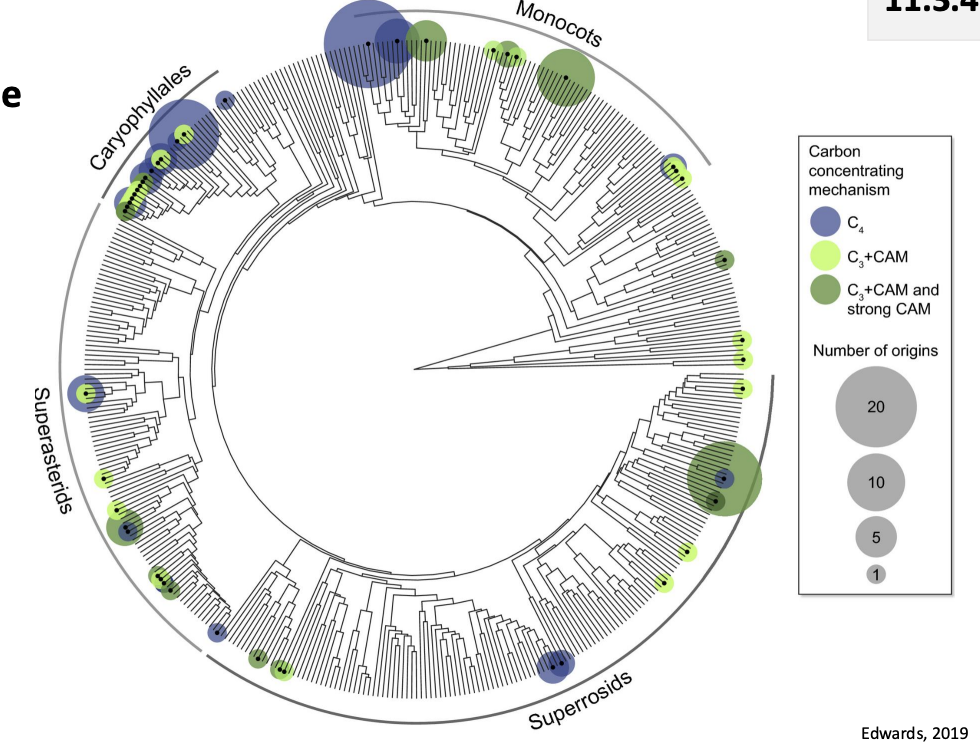
What this suggests?
Might be quite an easy step to make?
Is evolving from C3 to C4 easy?
Found correlation between bundle sheath physiology in C4
to
prescence of high activity of enzymes used for decarboxylation in cells around vascular system in C3 (in tobacco)
showed the products decarboxylated in the regions around the stem and then fixed carbon exported to the growing apices
→ Showed there are similar biochemistry found in the bundle sheath and the pathway just had to be rewired
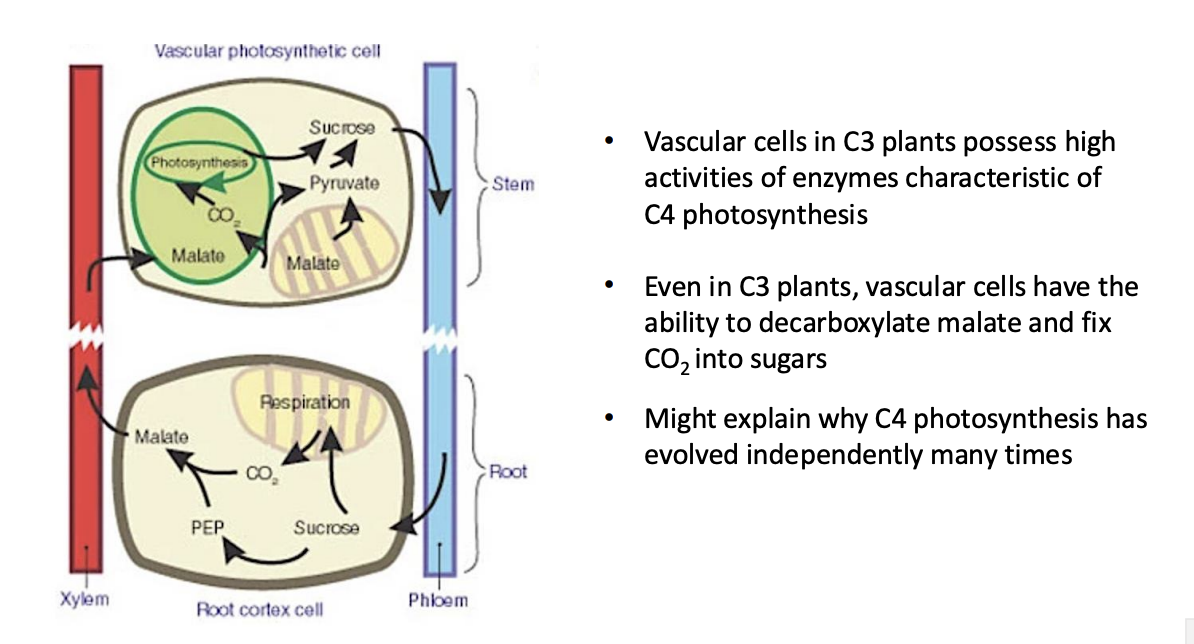
Future of C4 plants
Want to make Rice a C4 plant
Needed for food source
Feeds the most people
→ Make C4 to increase the yield